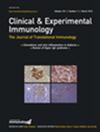The CXCL10-CXCR3 axis plays an important role in Kawasaki disease.
IF 3.4
3区 医学
Q3 IMMUNOLOGY
引用次数: 0
Abstract
The precise pathogenesis of Kawasaki disease remains unknown. In an attempt to elucidate the pathogenesis of KD through the analysis of acquired immunity, we comprehensively examined the immunophenotypic changes in immune cells such as lymphocytes and monocytes along with various cytokines, focusing on differences between pre- and post- treatment samples. We found high levels of CXCL9 and CXCL10 chemokines that decreased with treatment, which coincided with a post-treatment expansion of Th1 cells expressing CXCR3. Our results show that the CXCL10-CXCR3 axis plays an important role in the pathogenesis of KD.
CXCL10-CXCR3轴在川崎病中起重要作用。
川崎病的确切发病机制尚不清楚。为了通过获得性免疫分析来阐明KD的发病机制,我们全面检查了免疫细胞如淋巴细胞和单核细胞以及各种细胞因子的免疫表型变化,重点研究了治疗前和治疗后样本的差异。我们发现高水平的CXCL9和CXCL10趋化因子随着治疗而降低,这与治疗后表达CXCR3的Th1细胞扩增相一致。我们的研究结果表明,CXCL10-CXCR3轴在KD的发病机制中起重要作用。
本文章由计算机程序翻译,如有差异,请以英文原文为准。
求助全文
约1分钟内获得全文
求助全文
来源期刊
CiteScore
8.40
自引率
2.20%
发文量
101
审稿时长
3-8 weeks
期刊介绍:
Clinical & Experimental Immunology (established in 1966) is an authoritative international journal publishing high-quality research studies in translational and clinical immunology that have the potential to transform our understanding of the immunopathology of human disease and/or change clinical practice.
The journal is focused on translational and clinical immunology and is among the foremost journals in this field, attracting high-quality papers from across the world. Translation is viewed as a process of applying ideas, insights and discoveries generated through scientific studies to the treatment, prevention or diagnosis of human disease. Clinical immunology has evolved as a field to encompass the application of state-of-the-art technologies such as next-generation sequencing, metagenomics and high-dimensional phenotyping to understand mechanisms that govern the outcomes of clinical trials.

 求助内容:
求助内容: 应助结果提醒方式:
应助结果提醒方式:


